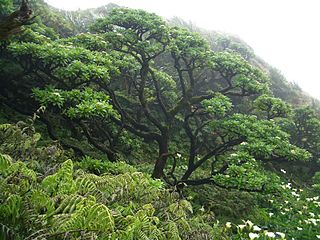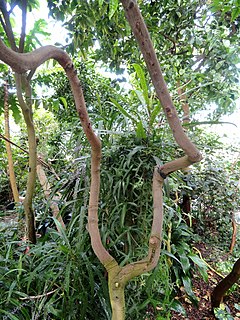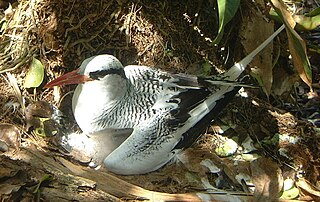
The Saint Helena scrub and woodlands ecoregion covers the volcanic island of Saint Helena in the South Atlantic Ocean. The island's remote location gave rise to many endemic species. First discovered and settled in the 1500s, the island has been degraded by human activities. Most of its native habitat has been destroyed, and many of its unique plants and animals are extinct or endangered.
Cabbage tree is a common name for several plant species:

The Saint Helena olive is an extinct species of flowering plant. It is the only member of the genus Nesiota. It was endemic to the island of Saint Helena in the South Atlantic Ocean. Despite its name, it is unrelated to the true olive, but is instead a member of the family Rhamnaceae, the family which contains buckthorns and jujube. The last remaining tree in the wild died in 1994, and the last remaining individual in cultivation died in December 2003, despite conservation efforts. It is thus a prime example of recent plant extinction. The Saint Helena olive belongs to the tribe Phyliceae, which are mostly endemic to Southern Africa.
Lachanodes arborea, the she cabbage tree, is a small tree in the family Asteraceae. It is an endangered endemic of the island of Saint Helena in the South Atlantic Ocean. It is now extinct in the wild.

Acalypha rubrinervis is an extinct plant in the spurge family (Euphorbiaceae), from the island of Saint Helena in the South Atlantic Ocean. It was called string tree on account of the thin pendulous inflorescences which resembled red strings. Disturbance following human settlement on the island destroyed its habitat and it was last seen in the 19th century. It is thus one of a number of island plants to have been driven to extinction by human activity.

Pladaroxylon is a genus of trees in the groundsel tribe within the sunflower family.

The flora of Saint Helena, an isolated island in the South Atlantic Ocean, is exceptional in its high level of endemism and the severe threats facing the survival of the flora. In phytogeography, it is in the phytochorion St. Helena and Ascension Region of the African Subkingdom, in the Paleotropical Kingdom.

Dicksonia arborescens, the Saint Helena tree fern, is a characteristic plant of the "tree fern thicket" vegetation of the highest parts of the central ridge of the island of Saint Helena. It is the type species of the genus Dicksonia.

Trochetiopsis erythroxylon, the Saint Helena redwood, is a species of plant, now extinct in the wild. It was formerly abundant enough in the upland parts of the island of Saint Helena for early settlers in the 17th century to use the timber to make their homes. It became extinct in the 1950's due to deforestation as it's habitat was cleared to make way for pasture, timber and fuel.

Trochetiopsis ebenus, the dwarf ebony or Saint Helena ebony, is a species of flowering plant that is endemic to the island of Saint Helena in the southern Atlantic Ocean. It is not related to the ebony of commerce, but is instead a member of the mallow family, Malvaceae. Saint Helena ebony is now critically endangered in the wild, being reduced to two wild individuals on a cliff, but old roots are sometimes found washed out of eroding slopes. These are collected on the island a used for inlay work, an important craft on Saint Helena. A related species, Trochetiopsis melanoxylon is now completely extinct.

Wahlenbergia roxburghii, the Roxburgh bellflower or dwarf cabbage tree, is an extinct member of a group of four species of Wahlenbergia once known from the island of Saint Helena, in the South Atlantic Ocean. It was last seen by naturalist John Charles Melliss in 1872. William Roxburgh recorded it in the thick forests on the south face of Diana's Peak. De Candolle notes it in dense woods around Diana's Peak and Halley's Mount. Burchell notes it 'On Sandy Bay ridge near Taylor's. Flowering: probably August to March. It was exceedingly rare in Meliss's time, it is not in his book as he had not found it. It was probably the increase of Phormium tenax planting on the ridge that pushed Wahlenbergia roxburghii into final extinction. It is an example of one of the early extinctions of Saint Helena plants as a result of human activity, with a history similar to that of the stringwood, .

Commidendrum robustum, the Saint Helena gumwood, is a species of tree endemic to Saint Helena, Ascension and Tristan da Cunha. Though it is now comparatively rare, it was once one of the most abundant trees of mid-elevations of the island of Saint Helena in the South Atlantic Ocean. A small tree to 7–8 m, it was cut extensively for fuel in the early years of settlement of the island by the English East India Company. It has given its name to certain placenames on the island such as "Gumwoods". It is one of several species in the endemic genus Commidendrum.

Lobelia scaevolifolia is a species of the plant family Campanulaceae. It is endemic to the island of Saint Helena in the South Atlantic Ocean. It was at one time placed as the only species, Trimeris scaevolifolia, in the genus Trimeris. Its common name is St. Helena lobelia.

Petrobium is a genus in the family Asteraceae.

Nesohedyotis is a genus of flowering plants endemic to the island of Saint Helena in the South Atlantic Ocean. It in the family Rubiaceae.

Sabal palmetto, also known as cabbage palm, cabbage palmetto, sabal palm, blue palmetto, Carolina palmetto, common palmetto, Garfield's tree, and swamp cabbage, is one of 15 species of palmetto palm. It is native to the Southern United States and the West Indies.

Diana's Peak is the highest point, at 818 metres (2,684 ft), on the island of Saint Helena, a British overseas territory in the South Atlantic Ocean. It is of volcanic origin. The mountain and its surroundings with a total area of 81 ha were proclaimed a national park in March 1996, the first on the island. It is a preserve of several endangered endemic species, including tree fern, he cabbage and black cabbage trees, and whitewood. The park contains walking paths connecting the peaks - Mt. Actaeon (814m), Diana's Peak and Cuckold's Point (815m). The two shorter peaks are topped by large Norfolk pines. On the northern slopes there is a nursery for endemic species.

The South-west Saint Helena Important Bird Area is a 45 km2 tract of land covering about 37% of the island of Saint Helena, a British Overseas Territory in the South Atlantic Ocean. It has been identified by BirdLife International as an Important Bird Area (IBA) because it supports several colonies of breeding seabirds, including the red-billed tropicbird, as well as habitat of the endemic, and critically endangered, Saint Helena plover.
















